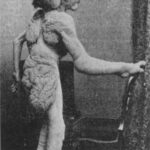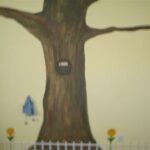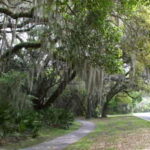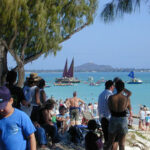On the outside walls of the Blessed Sacrament Church in Stowe, Vermont, murals depict the work of Brother Joseph Dutton who spent half his life helping the lepers of the Kalawao Colony on the island of Molokai, Hawaii.
Twelve murals adorn the two long sides of the church. They seem crude, almost childlike, but you’ll be instantly drawn to them. Each mural provides a tiny glimpse into the world of Kalawao, a leper colony that once existed on Molokai, Hawaii. On all the murals is the figure of Brother Dutton, a man who spent forty-three years tending to the needs of those abandoned lepers and over whose birthplace the church sits.
Most people are more familiar with Father Damien de Veuster who first organized the Kalawao colony, than Brother Dutton. Part of the reason, beyond the work Father Damien did, lay in his early death from the disease he had hoped to conquer. He became the face of what seemed a hopeless fight.
But Dutton, who arrived unannounced at Kalawao on July 29, 1886, ready to fulfill his desire for a life of penance, proved equally dedicated. Within three years Damien had died and Dutton gladly shouldered the burden. For over forty years he never wavered, washing sores, dealing with ulcers, doing rudimentary surgery, building, and writing to presidents, princes, and medical people for help. He never left the Kalaupapa peninsula where Kalawao is located.
Within twenty years progress had been made. The deaths had been lessened considerably and the settlement, finally well-supplied because of Dutton’s letters, had electricity, an ice plant, government stores, and autos owned by the patients. Years later, medicines would make such a colony unnecessary.
As early as the second decade of the twentieth century a church had been planned to honor Stowe’s famous son. But it wasn’t until the arrival of the Rev. Francis McDonough in 1947, with the help from the late Maria von Trapp of Sound of Music fame, that the dream became a reality. A practical reason also existed for erecting a new church. Up until then Stowe’s worshipers had to spend Sunday mornings in the basement of the town hall.
Letting the public know of Brother Dutton, who moved through half his eighty-eight years as a successful Civil War soldier and businessman and the last half as a penitent lay brother, remained a prime goal of Father McDonough. And he intended to use fully the church’s exterior walls to get the message across.
The thick-lined, lively paintings are reminiscent of the French painter, George Rouault. His student, Andre Girard, stepped forward after the church had been completed and offered to paint the walls and interior, asking only for paint and a place to stay. Using passages from the book “Damien the Leper” and a booklet by Father McDonough, Girard portrayed events in the colony. At first glance the drawings may seem primitive, but like good primitive paintings the feelings they’re meant to represent radiate from the outward simplicity.
The murals touch upon moments of hope, despair, and solace. You’ll notice few displays of joy. In a number of scenes, gaunt-faced lepers surround or lean toward the figures of Damien and Dutton, the lepers last two slivers of hope – and decency. Another mural shows a sometimes-daily occurrence as a leper, wrapped in a shroud, is lowered into a grave. One particular scene shows a pained Dutton kneeling at the the bier of the dead Damien.
The terror leprosy induced in others and the sense of abandonment it instilled in the lepers is shown powerfully. A dark figure stands on shore his arms raised in fury at a distant schooner. Small objects dot the water. Fearful of landing, sailors at times simply threw supplies for the colony into the ocean hoping the currents would carry them ashore. No wonder those sent to Kalawao called it the “living tomb”.
Yet Dutton, for his dedication to Kalawao, never lost interest in the wider world. He wrote hundreds of letters and remained a true patriot at heart. At the start of World War I, he asked to lead his old Civil War regiment into battle. Turned down, he sent his binoculars instead. Franklin Roosevelt, the Secretary of the Navy, returned them after the war and said they had found honorable duty aboard a destroyer.
The final mural shows how Dutton’s fame had spread. He stands on the shore, the American flag waving above him, a line of ships on the horizon. In 1908, President Theodore Roosevelt, at Dutton’s request, diverted the Great White Fleet from its around-the-world voyage showcasing American power so it could pass before the colony. As the fleet steamed past, each of the sixteen battleships, the U.S.S. Vermont among them, dipped their flags to Dutton and the excited lepers around him.
Be sure to enter the church. the faces so prominent on the outside are carried inside, covering every inch of the ceiling. But now the lines are more delicate, the faces more joyous and unblemished, as though released from their torment.
Dutton died in March, 1931. Vermont, for which he always retained a special feeling even to the point of adding pictures of Stowe to his letters, didn’t forget him. In 1952, the Trapp Family singers visited Molokai and sang over his grave.
“Gently, Johannes placed our Mount Mansfield pine wreath at the foot of the cross,” wrote Maria von Trapp. “With Father McDonough leading, each one of us added a lei to the grave and whispered, ‘Aloha Brother Dutton. Greetings from Stowe”.
Sources used: Joseph Dutton: His Memoirs, edited by Howard Case, Blessed Sacrament Church archives, personal visit.







